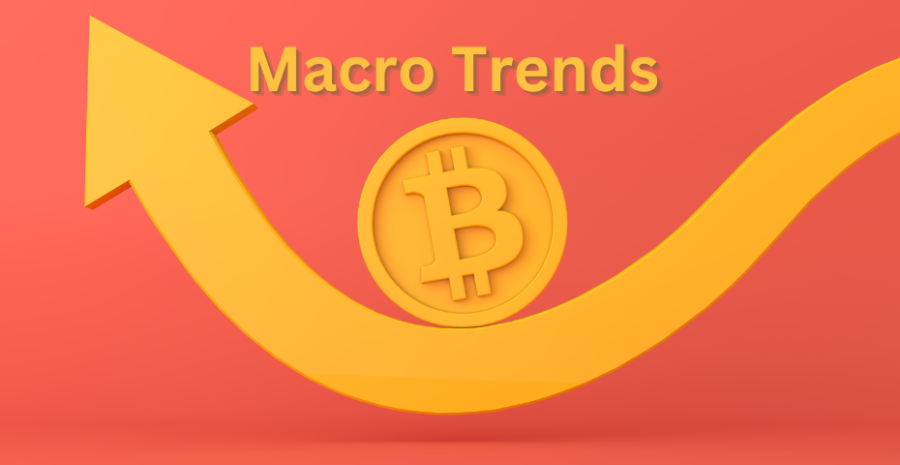
Understanding the Implications: Bitcoin's Latest Surge to $59,000 Explained.

Introduction:
In the ever-evolving landscape of cryptocurrency, the recent surge in Bitcoin's price to $59,000 has sent shockwaves throughout the financial world. This dramatic rise prompts a deeper examination into the underlying factors propelling this digital asset to new heights. Understanding the implications of Bitcoin's latest surge requires a comprehensive analysis of market dynamics, investor sentiment, and technological advancements driving adoption.
As enthusiasts and analysts alike delve into the intricacies of this surge, questions arise about its sustainability and the potential ramifications for the broader financial ecosystem. With Bitcoin's halving event looming on the horizon, slated for later this year, anticipation mounts regarding its impact on the price trajectory. The halving, a significant event that occurs approximately every four years, entails a reduction in the rate of new Bitcoin supply, historically leading to price appreciation.
As we navigate these uncharted waters, investors are keenly observing market trends and expert insights to gauge the future direction of Bitcoin's price post-halving. Will the historical patterns hold true, fueling further price escalation, or will external factors exert unforeseen influences on the market? Understanding the implications of Bitcoin's surge to $59,000 necessitates a holistic perspective that considers both technical analysis and fundamental drivers.
In this introduction, we embark on a journey to unravel the complexities surrounding Bitcoin's recent surge and forecast its future trajectory in the wake of the impending halving event. Through diligent examination and informed speculation, we aim to shed light on the factors shaping the destiny of this pioneering cryptocurrency and offer insights into what lies ahead for investors and enthusiasts alike.
Predicting the future price of Bitcoin is inherently speculative, ( some predict $100.000 later this year & some as high as $250,000) influenced by a myriad of factors including market sentiment, adoption trends, regulatory developments, and macroeconomic conditions. However, based on historical patterns and current market dynamics, many analysts foresee a bullish trajectory for Bitcoin later this year. With the upcoming halving event expected to reduce the rate of new supply, supply-demand dynamics may tilt in favor of price appreciation. Moreover, growing institutional interest and mainstream adoption could further bolster confidence in Bitcoin as a store of value and hedge against inflation.
Some experts anticipate Bitcoin surpassing previous all-time highs and potentially reaching new milestones, fueled by increased institutional investment and retail participation. However, volatility remains a constant feature of the cryptocurrency market, and sharp price fluctuations cannot be ruled out. Additionally, regulatory developments and geopolitical tensions may introduce uncertainty into the market, impacting investor sentiment and influencing short-term price movements.
Overall, while short-term fluctuations are inevitable, the long-term outlook for Bitcoin appears optimistic, with many proponents projecting continued upward momentum fueled by increasing adoption, scarcity, and recognition as a legitimate asset class. Investors should exercise caution, conduct thorough research, and diversify their portfolios to mitigate risks associated with cryptocurrency investments.
1. Capturing the attention of investors and enthusiasts worldwide:

The cryptocurrency world is abuzz with excitement as Bitcoin, the pioneer of digital currencies, has surged to a remarkable price point of $59,000, capturing the attention of investors and enthusiasts worldwide. Capturing the attention of investors and enthusiasts worldwide, Bitcoin's meteoric rise has become a focal point of discussions in financial circles and beyond.
The cryptocurrency's remarkable ascent from obscurity to mainstream recognition has ignited curiosity and speculation among seasoned investors and newcomers alike. Its disruptive potential and the allure of significant returns have drawn the interest of traditional financial institutions, hedge funds, and individual investors seeking exposure to this emerging asset class.
Enthusiasts, passionate about decentralization and financial sovereignty, champion Bitcoin as a revolutionary technology with the power to reshape the global economy. Amidst the buzz and excitement, debates rage on about Bitcoin's intrinsic value, its role in a diversified investment portfolio, and its potential to usher in a new era of financial innovation.
As the digital currency continues to make headlines and capture the imagination of millions, its journey from an experimental concept to a global phenomenon underscores the transformative impact of blockchain technology on society and finance.
2. Market Dynamics:

The sudden surge in Bitcoin's price raises questions about the underlying factors driving this unprecedented rally. Analysts are closely examining market dynamics to understand the forces at play. Market dynamics encompass the intricate interplay of supply and demand forces that shape price movements and market trends.
These dynamics are influenced by a myriad of factors, including investor sentiment, economic indicators, geopolitical events, and regulatory developments. Understanding market dynamics is crucial for investors and traders to anticipate price movements and make informed decisions. The constant flux between buyers and sellers creates volatility and opportunities for profit, as well as risks.
Market dynamics also reflect the collective psychology of market participants, oscillating between fear and greed, optimism and pessimism. Analyzing these dynamics requires a holistic approach, incorporating fundamental analysis, technical analysis, and behavioral finance principles to navigate the complexities of financial markets effectively.
3. Institutional Adoption:
.png)
One major factor contributing to Bitcoin's surge is the increasing adoption by institutional investors. Companies and financial institutions are increasingly recognizing Bitcoin as a legitimate asset class and allocating funds accordingly. Institutional adoption of cryptocurrency, particularly Bitcoin, marks a significant paradigm shift in the traditional financial landscape.
Major corporations, hedge funds, and institutional investors are increasingly recognizing the potential of digital assets as a legitimate investment class. This institutional endorsement brings credibility and stability to the cryptocurrency market, fostering greater mainstream acceptance. Institutions are attracted to Bitcoin's scarcity, its potential as a hedge against inflation, and its uncorrelated nature to traditional assets.
Moreover, the infrastructure supporting institutional investment in cryptocurrencies, such as custodial services and regulated exchanges, continues to mature, further facilitating adoption. As more institutions allocate funds to Bitcoin, the asset's market capitalization grows, reinforcing its status as a store of value and paving the way for broader institutional participation in the digital asset space.
4. Investor Sentiment:
.png)
Positive investor sentiment plays a crucial role in driving Bitcoin's price higher. Confidence in the long-term potential of Bitcoin as a store of value and hedge against inflation is fueling demand and driving up prices. Investor sentiment plays a pivotal role in shaping market trends and driving asset prices.
The collective mood and outlook of investors towards a particular asset, such as Bitcoin, influence buying and selling decisions, thereby impacting its price trajectory. Positive investor sentiment, characterized by confidence and optimism, often leads to increased buying activity and upward price momentum. Conversely, negative sentiment, marked by fear or uncertainty, can trigger sell-offs and price declines.
Factors such as news events, market sentiment indicators, and macroeconomic trends all contribute to shaping investor sentiment. Monitoring and understanding investor sentiment is crucial for investors to anticipate market movements and adjust their strategies accordingly, as sentiment can be a powerful driver of short-term price fluctuations in the cryptocurrency market.
5. Supply and Demand Dynamics:

Bitcoin's limited supply, coupled with growing demand, creates a supply-demand imbalance that pushes prices upward. The upcoming halving event, which reduces the rate of new supply, further adds to Bitcoin's scarcity and bullish sentiment.
Supply and demand dynamics are fundamental principles that underpin market behavior, influencing the price of assets like Bitcoin. In the context of Bitcoin, its fixed supply of 21 million coins creates scarcity, driving demand and consequently prices higher. As demand for Bitcoin increases, particularly amidst growing institutional adoption and mainstream acceptance, its limited supply becomes more apparent, amplifying its value proposition as a store of value.
Conversely, fluctuations in demand, whether due to macroeconomic factors, regulatory developments, or investor sentiment, can impact prices accordingly. Understanding the delicate balance between supply and demand is essential for investors to gauge market sentiment and anticipate price movements in the dynamic cryptocurrency landscape.
6. Macro Trends:

Macroeconomic factors such as inflationary concerns, currency devaluation, and geopolitical tensions are driving investors towards alternative assets like Bitcoin, seeking protection against economic uncertainty. Macro trends encompass broad, overarching factors that exert influence on various aspects of the economy, including the cryptocurrency market.
In the context of Bitcoin, macroeconomic trends such as inflationary pressures, currency devaluation, and geopolitical uncertainties play a significant role in shaping investor behavior and market dynamics. As a decentralized digital asset, Bitcoin is often viewed as a hedge against traditional financial risks and macroeconomic instability.
Therefore, during periods of economic uncertainty or currency depreciation, demand for Bitcoin may rise as investors seek alternative stores of value. Additionally, evolving regulatory landscapes, technological advancements, and shifts in consumer behavior contribute to macro trends that impact the broader adoption and acceptance of Bitcoin as a viable asset class in the global financial ecosystem.
Understanding these macro trends is essential for investors to navigate the complexities of the cryptocurrency market and position themselves strategically for long-term growth and resilience.
7. Technical Analysis:

Technical indicators and chart patterns provide valuable insights into short-term price movements. Traders and analysts are closely monitoring key support and resistance levels to gauge Bitcoin's future trajectory. Technical analysis is a valuable tool used by traders and investors to analyze historical price data and identify potential trends and patterns in asset prices, including Bitcoin.
By examining charts, indicators, and price movements, technical analysts seek to predict future price movements based on past behavior. Common techniques include trend analysis, support and resistance levels, and various chart patterns such as triangles, head and shoulders, and double bottoms.
Technical analysis helps traders to make informed decisions by providing insights into market sentiment, momentum, and potential entry and exit points. While not without limitations, technical analysis can be a useful complement to fundamental analysis, offering a holistic approach to understanding and navigating the dynamic cryptocurrency markets.
8. Adoption as Payment Method:

The increasing acceptance of Bitcoin as a payment method by businesses and merchants also contributes to its price appreciation. Greater utility leads to higher demand and, consequently, higher prices. The adoption of Bitcoin as a payment method represents a significant milestone in its journey towards mainstream acceptance.
As businesses and merchants increasingly integrate cryptocurrency payments into their operations, Bitcoin's utility as a medium of exchange expands. This adoption is fueled by several factors, including lower transaction costs, faster settlement times, and greater security compared to traditional payment methods.
Furthermore, the growing global acceptance of Bitcoin as a legitimate form of currency encourages consumer confidence and incentivizes broader adoption. As more individuals and businesses embrace Bitcoin for everyday transactions, its role as a viable alternative to fiat currencies continues to strengthen, paving the way for a more decentralized and inclusive financial ecosystem.
9. Media Attention:

Media coverage and news headlines highlighting Bitcoin's surge generate FOMO (fear of missing out) among retail investors, driving further demand and pushing prices higher. Media attention surrounding Bitcoin has surged in recent years, reflecting the cryptocurrency's growing prominence in the global financial landscape.
With each new milestone, whether it be price surges, regulatory developments, or technological advancements, Bitcoin captures headlines and dominates news cycles worldwide. This extensive coverage serves to both inform and shape public perception, influencing investor sentiment and market trends.
Positive news stories often fuel optimism and drive demand, while negative reports can trigger volatility and uncertainty. Moreover, the rise of social media platforms and online forums amplifies the impact of media attention, enabling news to spread rapidly and reach a vast audience.
As a result, media coverage plays a crucial role in shaping the narrative surrounding Bitcoin, contributing to its ongoing evolution from a niche digital currency to a mainstream financial asset.
10. Conclusion:
Bitcoin's surge to $59,000 reflects a confluence of factors, including institutional adoption, positive investor sentiment, supply-demand dynamics, macroeconomic trends, and media attention. While the exact catalysts behind the surge may vary, the overall trend underscores Bitcoin's growing prominence as a disruptive force in the global financial landscape.
Investors should remain vigilant and informed, recognizing both the opportunities and risks associated with investing in cryptocurrencies. The surge of Bitcoin to $59,000 signifies a pivotal moment in the cryptocurrency's journey, underscoring its resilience and growing relevance in the global financial landscape.
Through a comprehensive analysis of market dynamics, institutional adoption, investor sentiment, supply and demand dynamics, macro trends, technical analysis, and adoption as a payment method, we've gained valuable insights into the factors driving this unprecedented rally.
While the exact catalysts behind Bitcoin's surge may vary, the broader implications are clear: Bitcoin is emerging as a credible store of value and an increasingly mainstream investment asset. As we navigate the uncertainties and opportunities presented by the cryptocurrency market, it's imperative to remain vigilant, informed, and adaptable in our approach to investing and understanding the profound implications of Bitcoin's latest surge.
(1).jpg)
About: Andries vanTonder
Over 40 years selfemployed
He is a Serial Entrepreneur, an Enthusiastic supporter of Blockchain Technology and a Cryptocurrency Investor.
Find me: Markethive Profile Page | My Twitter Account | My Instagram Acount | and my Facebook Profile.
